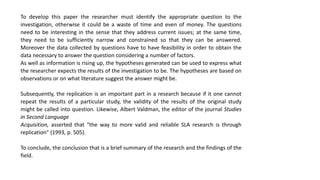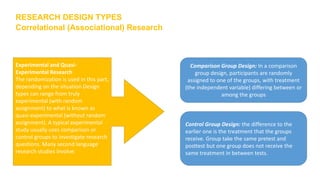The document provides guidance on conducting effective research. It discusses several key steps:
1) Identifying a clear research question that can be answered through investigation and data analysis. The question should address a current issue and be narrow enough to study.
2) Collecting and recording data in an organized manner, typically through a research report that outlines the study's purpose, methodology, findings, and conclusions.
3) Analyzing the results using appropriate methods depending on whether the data is quantitative or qualitative.
4) Ensuring ethical research practices, including obtaining participants' informed consent, protecting confidentiality, and considering participants' needs and perspectives. Pilot testing is also important to address any issues prior to the full





















![Its aim is to determine the strategies used when learning a second language
together with the variables that determine the selection of strategies
• when students are moving their lips, which might be an indication that they are preparing themselves
to speak by practicing under their breath,
• to what extent and which students are "buying processing time" by using such markers as 'uh' or 'well'
or other discourse markers designed to show that they wish to keep their turn,
• to what extent students are employing the compensation strategy of circumlocution (finding
alternative ways of saying something they don't know how to say),
• which students are asking a friend for help when they don't understand,
• which students are sounding out words before saying them,
• which students are reasoning by deduction ("it must mean this because of this"),
• which students are focusing on every word rather than the gist, perhaps by observing them as they
move their finger from word to word,
• which students plunge straight into [an] activity and which students spend some time planning their
work, and
• which students use the dictionary and with what frequency. (Macaro, 2001, p. 66)](https://image.slidesharecdn.com/epd-180515035500/85/Epd-22-320.jpg)
















